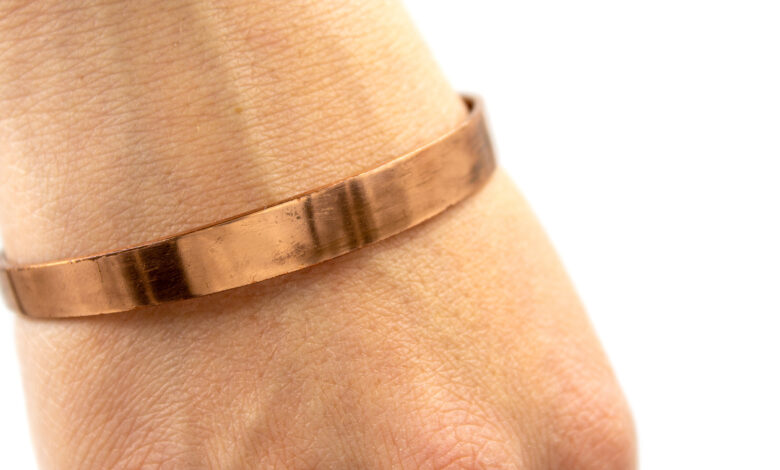MAGNETS & COPPER BRACELETS: Do they really work?

The question, “Do copper bracelets and/or magnets relieve the pain of arthritis?” has been asked for many decades. Patients who have used them have touted the benefits of copper forever and worn the bracelets confidently. The manufacturers and retailers of these products certainly promote them as therapeutically beneficial. But are they?
Patients who suffer from the pain of osteoarthritis or rheumatoid arthritis are the prime users of “alternative therapies” and agree completely. In one study of 199 patients, 68% of them had tried some form of alternative treatment (copper, magnets, herbs, etc). Of those who tried copper bracelets, 50% said they helped. But that’s not the conclusion of a thorough study done in Great Britain. This study was referenced in every source of information I found for this blog. I had many patients who wore copper bracelets, but no one ever asked if I thought they worked.
The theory behind the use of both copper and magnets is similar. Contact with the skin releases molecules that are absorbed and find their way into a nearby joint. When they reach joint fluid, these molecules exert a chemical affect on the fluid, reducing inflammation, and thus relieving pain. Wearing these objects every day is supposed to keep joint pain and swelling under control. Copper does play an important role in making red blood cells and is found in all body tissues. It aids in forming collagen, absorbing iron, and maintaining the immune system and nerve cells. Too much copper damages (kills) liver cells and can cause nerve damage. A copper bracelet, however, can’t release enough copper to reach harmful blood levels, but does enough copper get absorbed to really help arthritis pain?
That was the objective of a 2013 study by Richmond, Gundasa, et al. in Great Britain. Seventy patients, aged 33 to 79, with painful rheumatoid arthritis, were randomly assigned to wear four devices, for five weeks each, to determine if they had a therapeutic effect on their pain.
The devices were:
A standard magnetic wrist strap
A demagnetized wrist strap
An “attenuated” magnetic wrist strap
A copper bracelet
Each device was worn for 5 weeks with a one-week washout period between. The patient’s wore each of the 4 devices but did not know which one they were wearing.
Pain relief was the primary outcome measure and was determined by four methods:
A 100 millimeter visual analog scale-patient’s rated their pain on a visual scale
The McGill Pain Questionnaire-a detailed pain assessment questionnaire
Tender joint count-tested by study investigators
Swollen joint count-determined by study investigators
Inflammation was assessed by plasma viscosity and C-reactive protein blood tests-tests that measure and quantitate inflammation.
In all of the patients, the degree of disease activity and drug therapy were factored in as well.
Of the 70 patients, 65 completed outcome reports for all 4 devices. “Analysis of treatment outcomes DID NOT reveal any ‘statistically significant differences between the 4 devices in terms of their effects on pain, inflammation, physical function, disease activity, or medication use’.” “ Wearing a magnetic wrist strap or a copper bracelet did not appear to have meaningful therapeutic effect, beyond that of a placebo, for relieving symptoms…in rheumatoid arthritis.
Richmond, et al. repeated the same study in forty-five patients with osteoarthritis and reached the same conclusion. “Copper bracelets and magnetic straps are generally ineffective for managing pain, stiffness, and physical function in osteoarthritis. They reported that any perceived beneficial effect was “likely attributable to the placebo effect.”
Copper bracelets are the most “visible” of the many alternative therapies (AT’s) patient’s use. On the other hand, vitamins, bee venom, DMSO, herbs, and special diets are used by over 50% of osteoarthritis patients but are not seen or as obvious as copper bracelets. In a phone survey, 74% of 300 AT users interviewed felt copper helped their arthritis, but in this survey, bracelets were not compared against other treatments and patient bias was very evident.
Dr. G’s Opinion: Copper bracelets and magnets have NO PROVEN therapeutic benefit in patients with osteoarthritis or rheumatoid arthritis. They are, however, powerful placebos whose use should not be ridiculed or mocked. Patients with arthritis, especially rheumatoid, have so much pain that as far as I’m concerned, they are free to use whatever they feel helps improve their quality of life. If that’s a copper bracelet, so be it!
See “THE PLACEBO EFFECT” blog on DrGOpines.com.
References: Richmond SJ, Gunadasa S, Bland M, Macpherson H, Copper bracelets and magnetic wrist straps for rheumatoid arthritis—analgesic and anti-inflammatory effects: a randomised double-blind placebo controlled crossover trial. PLoS 2013 Sep 16;8(9):e71529
Harefuah. Complementary Medicine—the facts 2011 Aug;150(8):657-8, 687
Richmond SJ, Brown SR, Campion PD, et al. Therapeutic effects of magnets and copper bracelets in osteoarthritis: a randomised placebo-controlled crossover trial. Complement Ther Med, 2009 Oct-Dec;17(5-6):249-56.
Price JH, Hillman KS, Toral ME, Newell S. The public’s perceptions and misperceptions of arthritis. Arthritis Rheum. 1983 Aug;26(8):1023-8.
Camara K, Danao-Camara T. Awareness of, use and perception of efficacy of alternative therapies by patient’s with inflammatory arthropathies. Hawaii Med J. 1999 Dec;(12):329-32.
Struthers GR, Scott DL, Scott DG The use of ‘alternative treatments’ by patients with rheumatoid arthritis. Rheumatol Int. 1983;3(4):151-2.
Zhang S, et al. Effect of magnetic nanoparticles size on rheumatoid arthritis targeting and photothermal therapy. Colloids Surf B Biointerfaces 2018 Oct 1;170:224-232.




